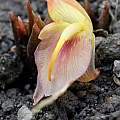Zingiber Mill. is a genus in the Zingiberaceae family found in southern & eastern Asia. Most of the genus is tropical & sensitive to frost, though a few species are root hardy to at least zone 8. Species bloom terminally on older stems or basally on stalked inflorescences which emerge directly from the fleshy rhizomes. These cone-shaped inflorescences can be quite colorful and are the source of the common name of pine cone gingers. Most species have highly aromatic foliage and rhizomes which emerge from pseudostems which can be anywhere between 1.5 to 15' tall. Zingiber officinale is the common edible ginger root.
Zingiber mioga (Thunb.) Roscoe is a deciduous perennial native to Japan, Taiwan and China. The young inflorescences are eaten in all of its range, which has spawned commercial growth in New Zealand and Australia. It is one of the hardiest Zingiberaceae (some reports see it hardy to USDA Zone 6), filling places in light shade with its tropical-looking foliage alone in spring and summer. The inflorescences break through the ground in early fall a few centimeters away from the stems, bearing relatively large, short lived flowers just above ground level. Height range: 3-4 ft. The basic form has whiteish-yellow flowers, but the now common cultivar 'Crûg's Zing', collected by Bleddyn and Sue Wynn-Jones on a Korean Island in 1997, adds a pink tinge to a cream background. Photos show a plant of said cultivar grown by Martin Bohnet.
Variegated forms of this are also in trade, 'White Feather' being among the most common ones. In this clone, the silvery variegation is most prominent on the edges of the leaves, while the flowers are the typical cream white of the species.
Zingiber officinale Roscoe, commonly known as ginger, is a perennial rhizomatous herb prized for its aromatic and spicy underground stem used in culinary, medicinal, and cosmetic applications. Native to Asia, it is widely cultivated and has naturalized across many warm, moist regions of the world. Height range: 2-4 ft. Photograph and text provided by Saket Shrotri.
Zingiber zerumbet 'Darceyi' is the variegated form of Zingiber zerumbet (L.) Roscoe ex Sm. This form is not only more colorful but thankfully somewhat less vigorous than the typical form. Height range: 4-6 ft. Photos by Alani Davis.







